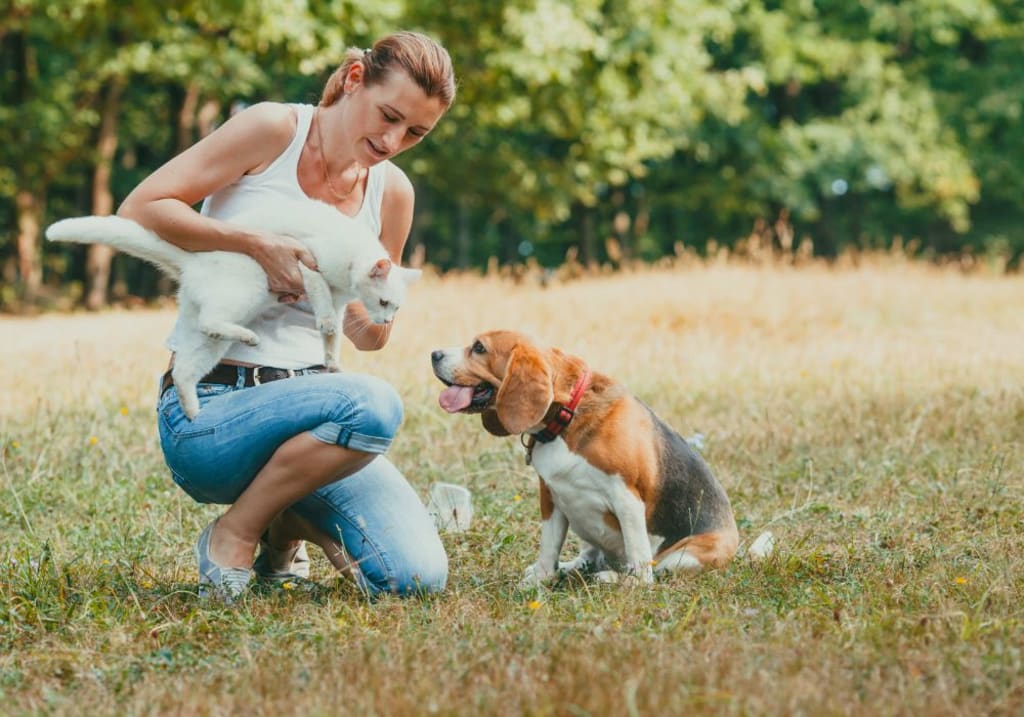
Introducing a dog to a cat can be a delicate process that requires patience, preparation, and positive reinforcement. While some dogs and cats may become best friends, it's essential to take the necessary steps to ensure a smooth transition and prevent potential conflicts. In this comprehensive guide, we'll provide you with valuable tips and strategies to help you successfully introduce your dog to your feline companion.
Preparing for the Introduction
- Assess your pets' personalities: Consider your dog's and cat's individual temperaments, energy levels, and past experiences with other animals. This information will help you determine the best approach for the introduction.
- Establish a safe space for your cat: Set up a room or area where your cat can retreat if needed, equipped with food, water, litter box, and comfortable resting spots. This will help your cat feel secure during the introduction process.
- Introduce scents beforehand: Swap blankets or towels between your dog's and cat's spaces, allowing them to become accustomed to each other's scents before the actual meeting. This can help reduce stress and anxiety.
- Train your dog: Ensure your dog knows basic commands like "sit," "stay," and "leave it." This will help you maintain control during the introduction and reinforce positive behavior.
- Provide plenty of exercise for your dog: Before the introduction, take your dog for a long walk or playtime to burn off excess energy. A calm, relaxed dog is more likely to have a positive interaction with a cat.
The Introduction Process
- Keep your pets on leashes: During the initial meeting, keep both your dog and cat on leashes, held by two different people. This allows you to maintain control and separate them if needed.
- Choose a neutral location: Introduce your pets in a neutral area, such as a room neither pet considers their territory. This can help prevent territorial behavior and reduce the likelihood of conflict.
- Go slow and keep it positive: Allow your pets to approach each other at their own pace. Offer treats and praise when they interact calmly and positively. Never force them to interact or punish them for being cautious.
- Monitor their body language: Watch for signs of stress or aggression, such as growling, hissing, or raised hackles. If either pet seems uncomfortable, calmly separate them and try again another day.
- Supervise all interactions: Never leave your dog and cat alone together until you are confident they have formed a positive relationship. Always supervise their interactions, especially during mealtimes and playtime.
Establishing a Positive Relationship
- Provide plenty of positive reinforcement: Reward your pets with treats and praise when they interact calmly and positively. This will help them associate each other's presence with good things.
- Encourage separate spaces: Provide separate resources, such as food bowls, water, toys, and beds, to prevent competition and minimize potential conflicts.
- Engage in parallel play: Engage your dog and cat in separate but parallel activities, such as playing with toys or treats. This can help them associate each other's presence with positive experiences.
- Introduce new items gradually: When introducing new items, such as beds or toys, allow your pets to investigate them one at a time to prevent resource guarding or conflicts.
- Be patient and consistent: Building a positive relationship between a dog and cat takes time and consistency. Stick to a routine, and continue to reinforce positive behavior through training and praise.
Addressing Common Challenges
- Prey drive: Some dogs may have a strong prey drive, which can lead to chasing or harassing cats. If this is a concern, consult with a professional trainer or behaviorist to help manage and redirect this behavior.
- Territorial behavior: Both dogs and cats can exhibit territorial behavior, such as marking, growling, or hissing. Provide plenty of resources and separate spaces to minimize conflicts.
- Rough play: While some dogs and cats may enjoy playing together, it's essential to monitor their interactions to ensure they don't get too rough or aggressive. Interrupt any play that seems too intense or one-sided.
- Fear or anxiety: Some pets may experience fear or anxiety during the introduction process. If either your dog or cat seems consistently stressed or fearful, consider seeking the advice of a veterinarian or animal behaviorist.
- Redirected aggression: In rare cases, a dog or cat may redirect their aggression towards their owner during an introduction. If this occurs, calmly separate your pets and seek professional help to address the underlying issue.
Conclusion
Introducing a dog to a cat requires patience, preparation, and a positive approach. By following these tips and strategies, you can help ensure a smooth transition and increase the chances of your pets forming a positive relationship. Remember, every dog and cat is unique, and the introduction process may vary depending on their individual personalities and experiences. If you encounter any challenges or concerns, don't hesitate to seek the advice of a professional trainer or behaviorist to help you navigate the process successfully.
About the Creator
Hasan
Welcome...
In this site of mine you can learn amazing things and many information that you don't know so please subscribe to my site.
Enjoyed the story? Support the Creator.
Subscribe for free to receive all their stories in your feed. You could also pledge your support or give them a one-off tip, letting them know you appreciate their work.






Comments
There are no comments for this story
Be the first to respond and start the conversation.